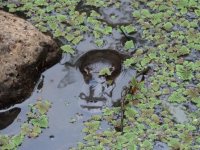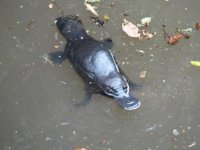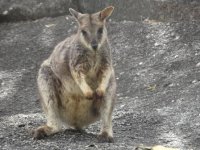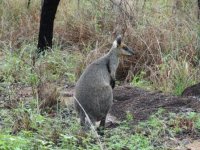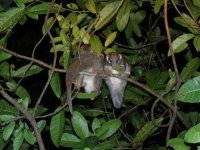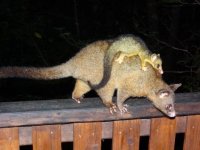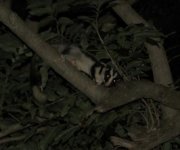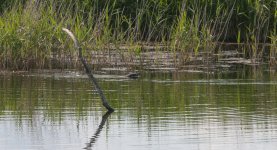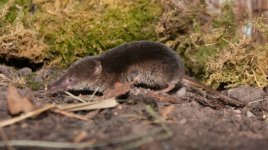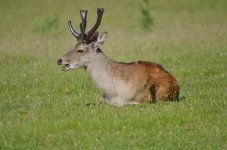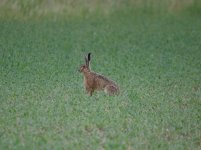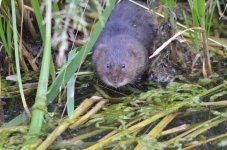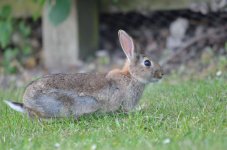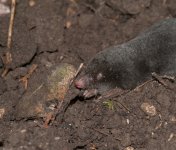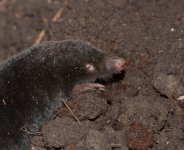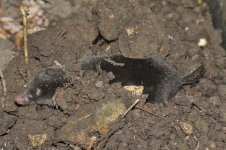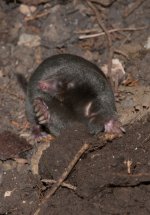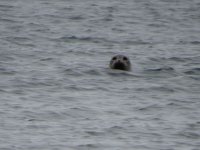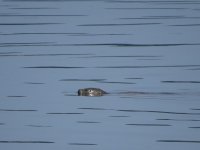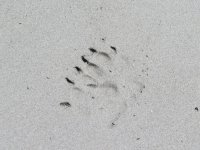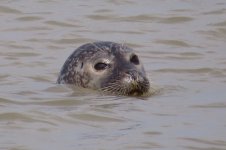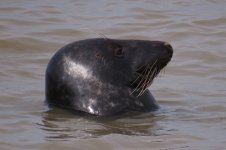-
Welcome to BirdForum, the internet's largest birding community with thousands of members from all over the world. The forums are dedicated to wild birds, birding, binoculars and equipment and all that goes with it.
Please register for an account to take part in the discussions in the forum, post your pictures in the gallery and more.
You are using an out of date browser. It may not display this or other websites correctly.
You should upgrade or use an alternative browser.
You should upgrade or use an alternative browser.
John's Mammals 2015 (1 Viewer)
- Thread starter Farnboro John
- Start date
More options
Who Replied?Thought I would add just a few mammals from the Southern Hemisphere to this great thread - and being careful to avoid bragging.
All these are from within 150km of my house.
Two shots of Platypus
Mareeba Rock Wallaby
Black or Swamp Wallaby
All these are from within 150km of my house.
Two shots of Platypus
Mareeba Rock Wallaby
Black or Swamp Wallaby
Attachments
and second part with three possums.
Green Ringtail Possum
Coppery form of Common Brushtail Possum
Striped Possum (from my garden)
Look forward to more or your fantastic photos
Green Ringtail Possum
Coppery form of Common Brushtail Possum
Striped Possum (from my garden)
Look forward to more or your fantastic photos
Attachments
Mike Richardson
Formerly known as Skink1978
Some fantastic photos there Dom. I was lucky enough to see most of these species several years ago, although the one I most wanted to see was the Striped Possum. Needless to say this was the one I missed.
Farnboro John
Well-known member
Thank you very much Dom, photos most welcome! I think your big risk now is ending up providing touring resource for BFers heading South.
Cheers
John
Cheers
John
Farnboro John
Well-known member
Yesterday Clare and I had a day out in Devon. The principal target was the River Otter Beavers, and we opened with a longish walk along the river looking for evidence of their presence and favoured areas. To my surprise we found nothing like the amount of positive evidence that is present all along the River Ericht in Scotland and although I had done my research and was fairly sure from little things I saw, I couldn't quite rid myself of nagging doubts as to whether or not we had the right stretch of river.
These doubts were allayed by two separate old ladies who regularly walked the riverbank and gripped us off fairly severely with respective tales of Beavers progressively dismantling trees and stripping bark right in front of them. One of them pointed out to us the spot where the regular local beaver-watchers congregate. In addition I spotted a truncated branch tip (dunno how I missed it earlier) showing the distinctive chomp marks of razor-sharp incisors. The river had masses of Blackcaps along it and a healthy Kingfisher population: judging from frequency and numbers of sightings (and some fighting) we definitely had a couple or more pairs along the section we walked.
As it was now mid-morning and the chances of seeing any beaver action until evening were small, we left the site and headed to Aish Tor to photograph High Brown Fritillaries. Easier said than done..... both High Brown and Dark Green Fritillaries occur here, but the principal problem was that neither species seemed disposed to stop at all, scorching around over the bracken-covered hillsides at speeds best measured by Mach number. After two and a half hours we had positively identified photos of both species but not exactly competition winners! On the plus side Clare nailed a cracking Green Hairstreak still looking very fresh. We took a break for drinks and sarnies, then returned to the fray, but it was late afternoon before the butterflies moderated their high-speed antics and began to perch for seconds at a time to feed on bramble flowers. We ended up fairly pleased with our efforts, but it was possibly the hardest work photographing wildlife I've done this year.
Clare spotted a Stoat at the edge of the closed tarmac road, and we had good but brief views of it running to and fro between the vegetated hillside and a drystone wall marking the boundary of the open tor. She staked the site out for some time but of course it wouldn't show for the camera.
We left the tor to return to the River Otter and an evening beaver stakeout at the spot one of our elderly acquaintances had advised, and saw another Stoat briefly by the side of the road not far from the village where we parked to walk along the river. As we walked in, we checked a weir for Dipper (Clare had seen one for a few seconds in the morning) but the presence of a fly-fisherman ruled that out. Further up we had three Grey Wagtails, two juveniles and an adult.
Up at our chosen spot we found a local already patiently waiting. He told us someone else had seen an Otter with a cub the previous evening, and there were recent sightings of beavers, which was definitely reassuring. While we waited we had several Kingfisher sightings and a Dipper showed a few times on small gravelly rapids a little below where we waited.
There were small fish jumping and lunging at flies at the water surface, and we kept seeing ripples emanating from under the opposite bank right in front of us, without ever seeing the animal causing them. When occurring the ripples were constant - a normal feature of aquatic mammals which are constantly in motion - but we kept seeing distinct and lengthy breaks as if the animal was retreating up the bank away from the water and then returning. It was all very puzzling: a Water Shrew or Mink would have moved left or right along the bank to places we could see it: an Otter would have been less circumspect: fish produce ripples as they break the surface but those do not persist.
At about ten to eight Clare hissed "There's a Beaver!" as she had spotted an adult European Beaver floating among debris retained by a fallen tree. It quickly vanished back among the tree branches and we were left on tenterhooks until it re-emerged from the point where the ripples had started again. I was astonished: it hadn't seemed to me the overhang could accommodate this large animal, but there you go.... The Beaver dived just before I got the camera lined up and all I recorded was its disappearing rump.
There was a further period of tension before it again glided into view and for the following forty minutes gave a command performance only yards away from us. We saw beaver doing home improvements (the lodge was right there), beaver feeding on leaves and branches, beaver neatly chopping bark from fallen tree branches: swimming, diving, waddling mostly up onto the bank so we could see part of that remarkable rubbery paddle stuck on the back end. Breathtaking stuff! Emerging this early of course there was a sensible amount of light so cameras were in frequent action, though we did also take time to just enjoy the experience.
Eventually the animal set off up-river and rather than follow it we wended our way back to the car and onwards to our last stop of the evening, a Hazel Dormouse stakeout. Unfortunately Roger's dormice hadn't performed by 2300, when we had agreed we would head home. It was not a moment too soon, because I was absolutely shattered and drove well below the speed limit much of the way home, not feeling up to going faster. Arrive alive is the watchword.
Obviously I am content to give regulars who would like directions to closer Beavers than Scotland, exact information. However, there is a question in my mind as to whether or not to publicise the exact site on here. The Beavers are fairly solidly established. The locals - both in and not in favour (the latter being anglers) - know exactly where they are, and there is plenty of information available for a keen person to find and see them. Presumably one of the arguments for them is enhanced tourism: it certainly wouldn't be right to expect that and not give Springwatchers a fighting chance of scoring. Against that there is a rather weak bleat from the DWT to not harass the youngsters, who are actually not likely to feel harassed as they don't have a model for assessing humans. I didn't have help from DWT and owe them no duty of confidence. What does the congregation think?
Stand by for Awesome Beaver Shots!
John
These doubts were allayed by two separate old ladies who regularly walked the riverbank and gripped us off fairly severely with respective tales of Beavers progressively dismantling trees and stripping bark right in front of them. One of them pointed out to us the spot where the regular local beaver-watchers congregate. In addition I spotted a truncated branch tip (dunno how I missed it earlier) showing the distinctive chomp marks of razor-sharp incisors. The river had masses of Blackcaps along it and a healthy Kingfisher population: judging from frequency and numbers of sightings (and some fighting) we definitely had a couple or more pairs along the section we walked.
As it was now mid-morning and the chances of seeing any beaver action until evening were small, we left the site and headed to Aish Tor to photograph High Brown Fritillaries. Easier said than done..... both High Brown and Dark Green Fritillaries occur here, but the principal problem was that neither species seemed disposed to stop at all, scorching around over the bracken-covered hillsides at speeds best measured by Mach number. After two and a half hours we had positively identified photos of both species but not exactly competition winners! On the plus side Clare nailed a cracking Green Hairstreak still looking very fresh. We took a break for drinks and sarnies, then returned to the fray, but it was late afternoon before the butterflies moderated their high-speed antics and began to perch for seconds at a time to feed on bramble flowers. We ended up fairly pleased with our efforts, but it was possibly the hardest work photographing wildlife I've done this year.
Clare spotted a Stoat at the edge of the closed tarmac road, and we had good but brief views of it running to and fro between the vegetated hillside and a drystone wall marking the boundary of the open tor. She staked the site out for some time but of course it wouldn't show for the camera.
We left the tor to return to the River Otter and an evening beaver stakeout at the spot one of our elderly acquaintances had advised, and saw another Stoat briefly by the side of the road not far from the village where we parked to walk along the river. As we walked in, we checked a weir for Dipper (Clare had seen one for a few seconds in the morning) but the presence of a fly-fisherman ruled that out. Further up we had three Grey Wagtails, two juveniles and an adult.
Up at our chosen spot we found a local already patiently waiting. He told us someone else had seen an Otter with a cub the previous evening, and there were recent sightings of beavers, which was definitely reassuring. While we waited we had several Kingfisher sightings and a Dipper showed a few times on small gravelly rapids a little below where we waited.
There were small fish jumping and lunging at flies at the water surface, and we kept seeing ripples emanating from under the opposite bank right in front of us, without ever seeing the animal causing them. When occurring the ripples were constant - a normal feature of aquatic mammals which are constantly in motion - but we kept seeing distinct and lengthy breaks as if the animal was retreating up the bank away from the water and then returning. It was all very puzzling: a Water Shrew or Mink would have moved left or right along the bank to places we could see it: an Otter would have been less circumspect: fish produce ripples as they break the surface but those do not persist.
At about ten to eight Clare hissed "There's a Beaver!" as she had spotted an adult European Beaver floating among debris retained by a fallen tree. It quickly vanished back among the tree branches and we were left on tenterhooks until it re-emerged from the point where the ripples had started again. I was astonished: it hadn't seemed to me the overhang could accommodate this large animal, but there you go.... The Beaver dived just before I got the camera lined up and all I recorded was its disappearing rump.
There was a further period of tension before it again glided into view and for the following forty minutes gave a command performance only yards away from us. We saw beaver doing home improvements (the lodge was right there), beaver feeding on leaves and branches, beaver neatly chopping bark from fallen tree branches: swimming, diving, waddling mostly up onto the bank so we could see part of that remarkable rubbery paddle stuck on the back end. Breathtaking stuff! Emerging this early of course there was a sensible amount of light so cameras were in frequent action, though we did also take time to just enjoy the experience.
Eventually the animal set off up-river and rather than follow it we wended our way back to the car and onwards to our last stop of the evening, a Hazel Dormouse stakeout. Unfortunately Roger's dormice hadn't performed by 2300, when we had agreed we would head home. It was not a moment too soon, because I was absolutely shattered and drove well below the speed limit much of the way home, not feeling up to going faster. Arrive alive is the watchword.
Obviously I am content to give regulars who would like directions to closer Beavers than Scotland, exact information. However, there is a question in my mind as to whether or not to publicise the exact site on here. The Beavers are fairly solidly established. The locals - both in and not in favour (the latter being anglers) - know exactly where they are, and there is plenty of information available for a keen person to find and see them. Presumably one of the arguments for them is enhanced tourism: it certainly wouldn't be right to expect that and not give Springwatchers a fighting chance of scoring. Against that there is a rather weak bleat from the DWT to not harass the youngsters, who are actually not likely to feel harassed as they don't have a model for assessing humans. I didn't have help from DWT and owe them no duty of confidence. What does the congregation think?
Stand by for Awesome Beaver Shots!
John
Farnboro John
Well-known member
Pix of English European Beaver from yesterday. Ear tags are green, numbered EX317 (left ear) EX 319 (right ear). I did wonder why you would give a Beaver two identities (is it a schizophrenic?) but then I thought researchers could tell from what number comes back, which way the Beaver was going: so maybe its actually quite a clever idea.
John
John
Attachments
-
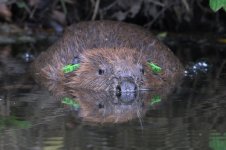 20150627 (22)_European_Beaver (800x533).jpg229.3 KB · Views: 42
20150627 (22)_European_Beaver (800x533).jpg229.3 KB · Views: 42 -
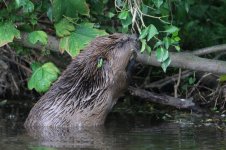 20150627 (24)_European_Beaver (800x533).jpg300.1 KB · Views: 36
20150627 (24)_European_Beaver (800x533).jpg300.1 KB · Views: 36 -
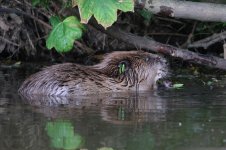 20150627 (25)_European_Beaver (800x533).jpg250.6 KB · Views: 35
20150627 (25)_European_Beaver (800x533).jpg250.6 KB · Views: 35 -
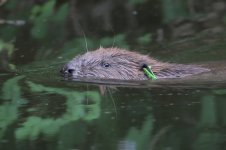 20150627 (28)_European_Beaver (800x533).jpg153.8 KB · Views: 37
20150627 (28)_European_Beaver (800x533).jpg153.8 KB · Views: 37 -
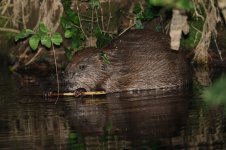 20150627 (29)_European_Beaver (800x533).jpg242.9 KB · Views: 34
20150627 (29)_European_Beaver (800x533).jpg242.9 KB · Views: 34
MarkHows
Mostly Mammals
I have been very busy of late with work so not had much time to update, so June in a few sentences.
So over recent weeks I bumped into an otter at Strumpshaw fen, unfortunately I only had a macro lens so the photos were not much to write home about. But nice local water voles were easier to prepare for.
A few traps were set for a discovery day at Fowlmere only a couple of captures but a rather nice common shrew was the pick. Sika deer at Arne were easy as normal and I have been bumping in hares everywhere.
And of course the mole, seen running down the path at the back of my house which was the real highlight of the month.
Mark
So over recent weeks I bumped into an otter at Strumpshaw fen, unfortunately I only had a macro lens so the photos were not much to write home about. But nice local water voles were easier to prepare for.
A few traps were set for a discovery day at Fowlmere only a couple of captures but a rather nice common shrew was the pick. Sika deer at Arne were easy as normal and I have been bumping in hares everywhere.
And of course the mole, seen running down the path at the back of my house which was the real highlight of the month.
Mark
Attachments
Thank you very much Dom, photos most welcome! I think your big risk now is ending up providing touring resource for BFers heading South.
Cheers
John
No worries very happy to provide info...though don't think the misses will want too many people sitting in the garden waiting for the possum (I can give other sites for that though!)
crazyfingers
Well-known member
We have a place on the coast of Maine and were up there for several days vacation.
A harbor seal was passing by the house the day we got there. Very gray weather.
A few days later one passed again. Nicer weather.
I also took a photo of these tracks in the sand. Porcupines are the most common animal that might make tracks these size. Possibly also a racoon.
I also saw a coyote run across the road, and I had to break the car not to hit it.
A harbor seal was passing by the house the day we got there. Very gray weather.
A few days later one passed again. Nicer weather.
I also took a photo of these tracks in the sand. Porcupines are the most common animal that might make tracks these size. Possibly also a racoon.
I also saw a coyote run across the road, and I had to break the car not to hit it.
Attachments
Farnboro John
Well-known member
We have a place on the coast of Maine and were up there for several days vacation.
A harbor seal was passing by the house the day we got there. Very gray weather.
A few days later one passed again. Nicer weather.
I also took a photo of these tracks in the sand. Porcupines are the most common animal that might make tracks these size. Possibly also a racoon.
I also saw a coyote run across the road, and I had to break the car not to hit it.
Those are canine tracks for sure. I can't judge the size so they could be Red Fox, Coyote or domestic dog - but certainly dog sp.
John
crazyfingers
Well-known member
Those are canine tracks for sure. I can't judge the size so they could be Red Fox, Coyote or domestic dog - but certainly dog sp.
John
Cool. There were no people tracks and being in a Wildlife refuge it should not be a domestic dog. So I guess fox or coyote. It's funny, or maybe expected as I don't know how they walk, but the tracks were always overlapping as that was. I expect the back paw landing where front paw landed.
Farnboro John
Well-known member
Cool. There were no people tracks and being in a Wildlife refuge it should not be a domestic dog. So I guess fox or coyote. It's funny, or maybe expected as I don't know how they walk, but the tracks were always overlapping as that was. I expect the back paw landing where front paw landed.
I did a quick google. Coyote looks right if you think the size fits. (Check, don't take my word for it.) Coyote tracks often have the rear feet landing on the front feet causing an overlap as shown in your photo. I haven't looked to see if foxes do too: perhaps you can do that.
In future if you photograph tracks, take two pictures: one of the track for aesthetic use, one with an easily scaled object: ruler ideally but coin, key, anything you can easily measure later and even more ideally something everybody will automatically know the size of if all they have is your photo.
Good picture though. Nice and clear. Its not always easy to get contrast on a fairly flat feature in level ground.
John
crazyfingers
Well-known member
I did a quick google. Coyote looks right if you think the size fits. (Check, don't take my word for it.) Coyote tracks often have the rear feet landing on the front feet causing an overlap as shown in your photo. I haven't looked to see if foxes do too: perhaps you can do that.
In future if you photograph tracks, take two pictures: one of the track for aesthetic use, one with an easily scaled object: ruler ideally but coin, key, anything you can easily measure later and even more ideally something everybody will automatically know the size of if all they have is your photo.
Good picture though. Nice and clear. Its not always easy to get contrast on a fairly flat feature in level ground.
John
I would say that the two prints as they are in the sand would be the width of my size 13 sneakers. I sometimes do and sometimes don't remember to put an object down for size.
I'll see what I can find about fox tracks but I think that the are not out of line for a coyote.
prhodes
Well-known member
We have a place on the coast of Maine and were up there for several days vacation.
A harbor seal was passing by the house the day we got there. Very gray weather.
A few days later one passed again. Nicer weather.
I also took a photo of these tracks in the sand. Porcupines are the most common animal that might make tracks these size. Possibly also a racoon.
I also saw a coyote run across the road, and I had to break the car not to hit it.
A walk along a Horsey Beach here in the UK also results in views of the local seals. Not so many this time of the year and they were staying in the water. Perhaps not surprising as I think they Grey Seals pup in the winter, and the Common / Harbour (apologies for the English spelling) are a bit scarcer in east Norfolk. (Please correct me if this is not accurate John).
(This was Sunday, but no sign of a certain large seabird on approach to Minsmere)
Attachments
Farnboro John
Well-known member
A walk along a Horsey Beach here in the UK also results in views of the local seals. Not so many this time of the year and they were staying in the water. Perhaps not surprising as I think they Grey Seals pup in the winter, and the Common / Harbour (apologies for the English spelling) are a bit scarcer in east Norfolk. (Please correct me if this is not accurate John).
(This was Sunday, but no sign of a certain large seabird on approach to Minsmere)
Commons pup much earlier than Greys and Common pups can swim immediately I understand.
I can't comment on local variation in occurrence in Norfolk, sorry. Your photos are one of each as far as I can see: the long-muzzled second photo being the Grey.
The only time I've watched seals in the Horsey area was when the Humpback Whale was there two autumns ago. Then the seals that came on the beach were being disturbed constantly, and even chased by out-of-control dogs: infuriating. I don't blame them for staying in the water.
John
prhodes
Well-known member
Commons pup much earlier than Greys and Common pups can swim immediately I understand.
I can't comment on local variation in occurrence in Norfolk, sorry. Your photos are one of each as far as I can see: the long-muzzled second photo being the Grey.
The only time I've watched seals in the Horsey area was when the Humpback Whale was there two autumns ago. Then the seals that came on the beach were being disturbed constantly, and even chased by out-of-control dogs: infuriating. I don't blame them for staying in the water.
John
Thanks John. Yes there were several uncontrolled dogs on the beach on Sunday as well (and a bloke swimming near the seals in his underpants - perhaps he hadn't noticed the size of a Grey Seals gnashers).
Interestingly, if you look at the Freinds of Horsey Seals website it asks people to keep there dogs on a lead, and it also seems to infer that fencing is put up during the Grey Seal pupping season, so perhaps things aren't too bad.
Phil
JCL
Well-known member
Pix of English European Beaver from yesterday. Ear tags are green, numbered EX317 (left ear) EX 319 (right ear). I did wonder why you would give a Beaver two identities (is it a schizophrenic?) but then I thought researchers could tell from what number comes back, which way the Beaver was going: so maybe its actually quite a clever idea.
John
Last night I tried for Beavers on the Otter. Dipped. Andy Swash told me that he had dipped at John's site, with the suggestion that they had moved from there. Andy suggested two further sites (based on friends' sightings). The first looked odd - v little overhanging vegetation - and I found it hard to imagine beavers there. The second, near Budleigh Salterton, looked v good. Plenty of locals passed by and enthused about seeing them - but not for the past 3-4 weeks. I stayed till dusk, without luck.
MarkHows
Mostly Mammals
Last night I tried for Beavers on the Otter. Dipped. Andy Swash told me that he had dipped at John's site, with the suggestion that they had moved from there. Andy suggested two further sites (based on friends' sightings). The first looked odd - v little overhanging vegetation - and I found it hard to imagine beavers there. The second, near Budleigh Salterton, looked v good. Plenty of locals passed by and enthused about seeing them - but not for the past 3-4 weeks. I stayed till dusk, without luck.
Nothing at John's site last night apart from a mink.
Mark
Similar threads
Users who are viewing this thread
Total: 2 (members: 0, guests: 2)




